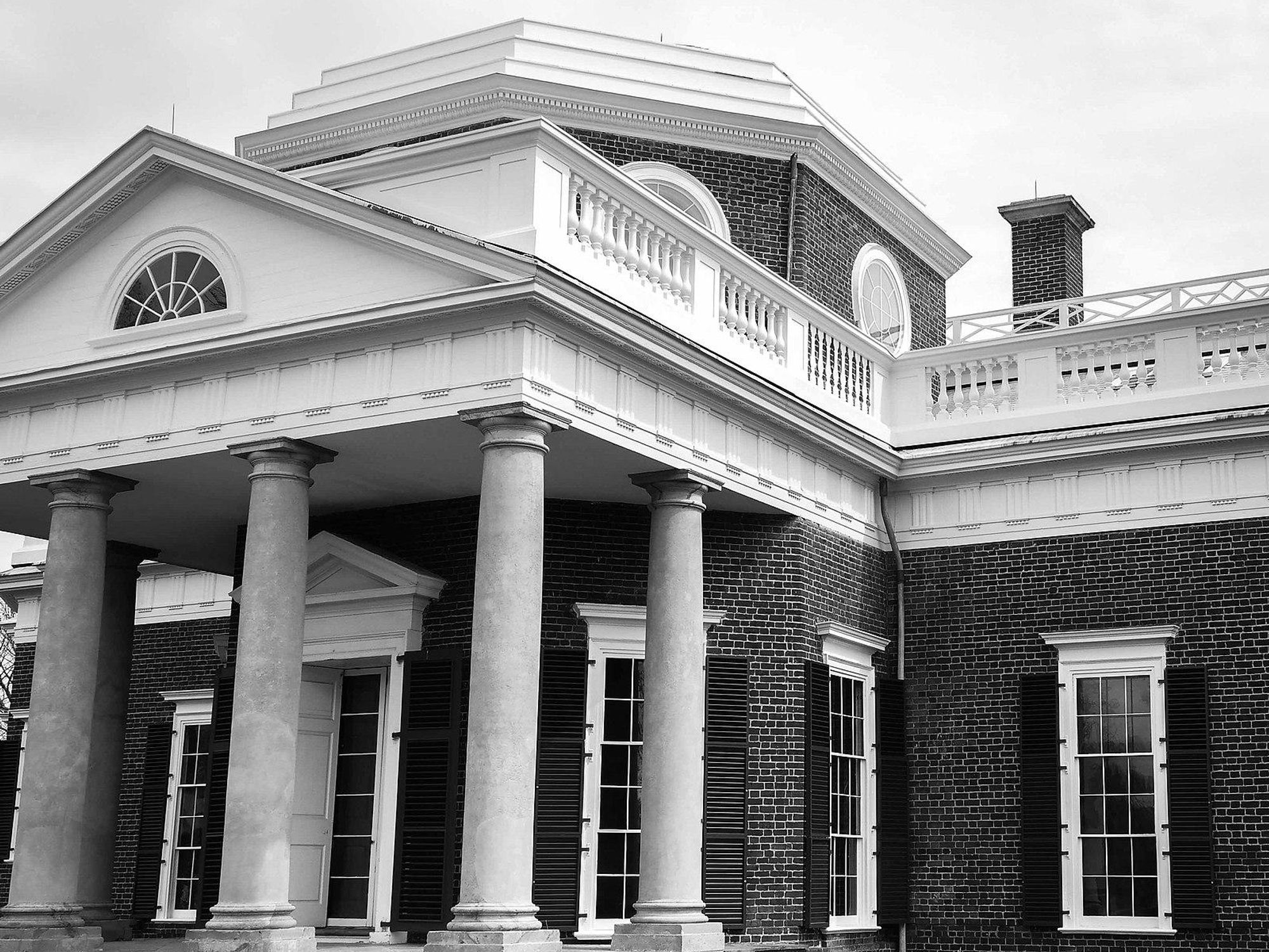
Thomas Jefferson's Monticello plantation
Reprinted with permission from Roll Call
When I visited Monticello, the home of America's third president, Thomas Jefferson, it was certainly impressive. But there was so much information shared by the friendly tour guide about the great man's genius that a lot was left out about just who was making the Virginia plantation turn a profit. Who was building the furniture and brewing the beer? Who was doing the planting?
When I asked the kindly woman for more details on the lived experiences of the enslaved men, women, and children at Monticello, her attitude grew decidedly chilly. And when I asked about Sally Hemings, who bore Jefferson's children, beginning when she was a young teen and Jefferson was in his 40s, well, the docent's face lost what little color it had and her rehearsed spiel descended into an unintelligible word salad. Then she changed the subject.
Blessedly, if I were to visit Monticello today, there is an exhibit devoted to Hemings, acknowledging the woman, known in Jefferson's time but disappeared or downplayed by histories, at least until historian Annette Gordon-Reed's books and other scholarship fueled conversations that DNA testing confirmed.
It wasn't just embarrassed guides at Monticello that misled for so long. Anyone relying on other cultural interpretations would have been clueless. In 2000, I wrote about a CBS offering, Sally Hemings: An American Scandal, which portrayed the relationship between a man of power and privilege and the woman he owned as straight out of a romance novel, complete with swelling chords and actor Sam Neill as Jefferson in a Fabio-style wig, locks blowing in a wind machine-generated breeze.
Disturbing, if a ratings grabber.
History, what is taught in the classroom, is vital if we are to understand the present. Right now, the country is embroiled in a contentious discussion over how much truth about systemic racism to allow in classrooms, with, unfortunately, little consideration of how and why promoting "fairy tale" history can damage schoolchildren of all ages and races.
But education extends past hours sitting at a school-room desk. Let's face it, a lot of folks absorb what we see on TV or in the movies as kind of true. We half-listen to a museum guide without questioning the motives of the people who crafted monuments and museums that shape memories of the dead.
Whitewashed images
There is a reason why many Americans believed that only "white guys" with crew cuts had the "right stuff" before "Hidden Figures" told the story of the Black women who fueled the space race. Though that film took some liberties, mathematician Katherine Johnson was able to get her flowers in public and in person before she died last year. She no doubt provided inspiration for African American schoolchildren previously discouraged from pursuing science and math careers, children who never saw themselves represented in whitewashed celluloid images.
I employ cultural references in my columns because a classic film or a summer song that everyone can hum is shorthand for shared community when so much else is polarized.
But there are dangers when you rely on those touchstones. In the phrase "based on a true story" tagged on to all those fictionalized tales, "based on" is doing a lot of heavy lifting. And predictably, just as in our history books, people of color are too often left out.
To be clear, no creator is compelled to cover all the bases when embarking on a project. The saying that people who are dissatisfied should stop complaining and make their own is fair, up to a point, since access and funds are definitely not available to everyone with an innovative idea.
But with gag orders being placed on teachers trying to lead students toward a complete and nuanced conversation about American history, the stories we tell — on big and small screens, in exhibitions — gain in importance.
Sometimes, the distortion is frivolous, as when the fractured timeline of "Back to the Future" had Michael J. Fox's Marty McFly inspiring Chuck Berry's signature rock and roll guitar riff. I laughed and cringed. It was a comedy.
Sometimes, though, it's serious, as in the case of 1988's "Mississippi Burning." Director Alan Parker used the excuse of creative license when he made heroes out of agents in J. Edgar Hoover's FBI, charged with investigating racist violence in the South in the 1960s, and relegated Black civil rights heroes and their allies to background characters. In reality, Hoover seemed more interested in snooping on Dr. Martin Luther King Jr.'s private life than racial justice. But Parker's vision won prizes.
Why does it matter?
Think of the enduring view of the post-Civil War West, set for generations by a public raised on the films of John Wayne, who is so revered he has an airport that bears his name. (And if you worship "The Duke," check out his 1971 Playboy interview laced with bigoted stereotypes about Black folks and Native Americans; his steadfast belief in "white supremacy" is pretty terrible.) For years, with a few notable exceptions, Westerns erased the tales of Blacks, Hispanics, Asians and Native Americans, except in stereotypical roles. Only in recent years have more folks learned, often through Hollywood, of the exploits of Nat (or Nate) Love, also known as Deadwood Dick, rodeo pioneer and actor Bill Pickett, and law enforcement officer Bass Reeves, whose stories had more drama than most.
America just commemorated the 100th anniversary of the 1921 Tulsa Race Massacre, which many only learned of when HBO's "Watchmen" recreated it. Life became art became life.
Changing The Narrative
Because the stories we tell become the world we live in, a diverse group of creators is building a new and necessary legacy, with expected pushback and criticism from those who think the discredited versions of history and the art that reinforced it were just fine.
Politicians already know how much culture shapes the narrative of America that people hold in their heads and hearts, which is why it's called a culture "war." In Texas — of course, Texas — there's a new battle of the Alamo, actually a law designed to entrench in education and at landmarks a sanitized myth epitomized by Wayne's 1960 "The Alamo," a myth that omits the role that protecting slavery played in the battle and the state's history.
In Washington, D.C., post-pandemic visitors may experience a new view of who deserves honors. The House voted this week to remove from display in the Capitol the bust of the late Chief Justice Roger B. Taney — who authored the infamous Dred Scott decision that held Black people were not U.S. citizens — along with statues and busts of Confederates and white supremacists. Taney would be replaced by Thurgood Marshall, the first Black Supreme Court justice. We'll see how the proposal fares in the Senate.
And when, years after my Monticello experience, I visited Montpelier, the plantation home of James Madison, the fourth U.S. president and Jefferson's slave-holding neighbor, archaeologists and volunteers were excavating bones, beads, shards of pottery, anything to discover a fuller picture of life there. It's been reported that found near a slave dwelling was a pipe bowl, ironically bearing the word "Liberty."
No "fairy tale" could be more poignant for Americans hooked on a good story.
Mary C. Curtis has worked at The New York Times, The Baltimore Sun, The Charlotte Observer, as national correspondent for Politics Daily, and is a senior facilitator with The OpEd Project. Follow her on Twitter @mcurtisnc3.
- Cultural Appropriation Has Become A Tedious Complaint - National ... ›
- In Racial Debacle At Smith College, A Warning To The 'Woke ... ›
- Republicans Warn That Opposing Racism Is A 'Communist' Plot ... ›
- Texas Governor's 'Patriotic Education' Law Puts Propaganda Over ... ›
- Poll: Fox's Carlson Driving Republican Racial Agenda - National ... ›
- On Fox News, 'Concerned Parents' Are Actually GOP Activists ... ›
- What Patriotism Means -- And Doesn't Mean -- In America Today - National Memo ›
- ‘Critical Race Theory’ Was Weaponized Against Obama In 2012 — And Flopped - National Memo ›
- How to Practice Culturally Relevant Pedagogy | Teach For America ›
- Sixteen Major Donors and Foundations Commit Unprecedented ... ›
- We're whitewashing the history of our founding. It's fueling problems ... ›
- The fight to whitewash US history: 'A drop of poison is all you need ... ›
- Resources for Teaching About Race and Racism With The New ... ›
- State GOP lawmakers try to limit teaching about race, racism ›
- Teachers protest against laws restricting lessons on racism - The ... ›








